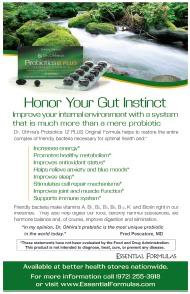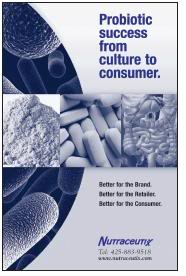It’s time to consider the gastrointestinal (GI) tract in a new light. Though it has the unglamorous function of breaking down food products and excreting the waste, it’s also a willing participant in the epic and heroic battle of good versus evil—bacteria, that is. Our knight in shining armor (A.K.A., the gut or GI tract) is home to trillions of beneficial bacterial flora that are essential for wellness. The villainous bad bacteria can take over under certain conditions, sabotaging our bodies with diarrhea, urinary tract infections, fatigue and other troubles.
Everything from poor nutrition to taking antibiotics to stress/fatigue can throw off the ratio of good to bad bacteria. But, probiotics (i.e., beneficial bacteria) can help keep the balance in good order by re-colonizing the army of good bacteria when their numbers become depleted.
“This is important since the body relies on these probiotics for several functions,” says Gene Bruno, MS, MHS, dean of academics at Huntington College of Health Sciences and consultant to Jarrow Formulas, Los Angeles, CA. He explains that we need probiotics for nutrient absorption, preventing colonization of bad bacteria and metabolizing foods and certain drugs. He also makes the point that not having enough probiotics in the body can have a slew of negative ramifications.
Straining to Understand Strains?
It’s important for retailers to remember some specifics about various beneficial bacteria strains (and their numerous) subcategories as many have unique and distinct health benefits in supplement form.
First is the Lactobacillus sp. species, often found in the small intestine where it has an important function. According to Lisa Peterson Love, marketing director for Sedona Labs, Cottonwood, AZ, “Lactobacilli strains assist in the processing of bile acids to digest food and nutrients and produce the all-important B-vitamins and enzymes in the small intestine that help digest and absorb food.”
|
|
Breaking down lactobacilli even further, one finds a familiar face: Lactobacillus acidophilus. This research-backed species, according to the Mayo Clinic, “produces vitamin K, lactase and anti-microbial substances.” On the latter point, experts say L. acidophilus can inhibit some common pathogens like Salmonella and E. coli that cause unpleasant digestive problems like cramping, vomiting and diarrhea (1).
Don’t assume every acidophilus strain is the same, however. Says Connie Falkenstein, RD, MS, MPH, director of marketing and education, UAS Laboratories, Inc., Eden Prairie, MN, “L. acidophilus is probably the most widely used probiotic in the country. Even L. acidophilus varies considerably by strain.” She suggests using “numbered (lettered) strains” that have clear research support.
For example, L. acidophilus R0052, according to the Jarrow Formulas Web site, helps break down lactose, which may be especially useful to shoppers who have difficulty digesting dairy products.
Another, L. acidophilus DDS-1 has long been studied by the University of Nebraska’s Khem Shahani (founder of Nebraska Cultures). This form is said to be more resistant to heat and severe environments (like that of the GI tract), “which makes it better to destroy and prevent colonization and reproduction of unfriendly bacteria, and maintain a healthy balance in the gut” (1).
Among the other important lactobacilli for digestion are:
- L. rhamnosus GG, which is said to address gastrointestinal disorders like diarrhea.
- L. casei, which may improve lactose intolerance and constipation,
- L. salivarius, for intestinal support and
- L. plantarium may help kill pathogens (1).
Experts also agree that bifidobacteria is an important probiotic for digestive health. One reason why may have to do with where they colonize: the colon. Says Bruno, “[Bifidobacteria] appear to be the most important organisms in the intestine in helping to create a microbial barrier to infection.” He adds that these probiotics produce “antimicrobial substances that are effective against many harmful gram-positive and gram-negative bacteria,” citing relevant research (2, 3).
Another mechanism of action, according to Peterson Love, may have to do with how bifidobacteria interact with fiber. “Bifidobacteria help bind toxins to fiber so that toxic chemicals and wastes are eliminated. They help detoxify the colon, produce essential B and K vitamins and amino acids, and aid in reducing constipation and supporting normal and healthy elimination—a vital aspect of normal digestion,” she explains. Taking several strains of bifidobacteria in one formula may work best. Such helpful bifidobacteria, say industry insiders, include:
- B. bifidum helps deactivate harmful bacteria and pathogens,
- B. lactis produces hydrogen peroxide, which destroys pathogens and
- B. longum is said to prevent gastrointestinal problems. B. longum BB536 and B. breve M-16V may be especially helpful for young children.
Peterson Love makes the point that there are numerous other beneficial bacteria. For example, she notes, “Lactococcus lactis produces folate, a B vitamin that assists in healthy digestion.”
For clients looking for lactose intolerance support, she explains that symptoms like bloating, flatulence, diarrhea, abdominal pain and burping may be relieved with the following strains: Streptococcus thermophilus, L. bulgaricus, L. acidophilus, B. longum and B. bifidus (4). Plus, Saccharomyces boulardii, a yeast probiotic, is said to thwart diarrhea associated with antibiotics use.
And, anyone taking antibiotics or recovering from surgery may benefit from probiotics. According to information from Solgar, a study of people on a post-operative optimization program (which included extra oxygen during surgery, regular walks after surgery, and taking a multi-strain probiotic of B. lactis, L. acidophilus, L. bulgaricus, and S. thermophilus plus oligofructose before and after) “regained energy quicker, were out of bed faster, and were eating a normal diet sooner than the people who had gotten standard care.”
Persnickety probiotics picking. Retailers, consider it fair game to be extra choosey about which probiotics you allow on your store’s shelves. Probiotics can have great benefits—but only if they’re formulated and taken properly.
First and foremost, choose strains (such as those previously mentioned) that have been shown to be functional in humans, says Angelica S. Vrablic, Ph.D., manager of nutrition research at NBTY, Inc., Ronkonkoma, NY. “Some products may use ‘new’ strains that were originally discovered in animals and are not known to be functional in the human gastrointestinal tract,” she feels.
|
|
In agreement is Frank Hodal, Jr., founder and CEO, Little Calumet Holdings, LLC, Beltsville, MD, makers of Vidazorb, who also recommends proprietary strains that have been proven in clinical studies. “Regardless of the species, strains that have been used in clinical research and found to be beneficial and then reproduced so they can be used commercially are always the best choice...The consumer needs to remember that just because it says ‘probiotics’ on the bottle doesn’t mean that all the bugs are the same quality.”
Keep in mind, too, advises Brenda Watson, founder and president of ReNew Life Formulas, Clearwater, FL, the area in the body you want to target. “Different probiotic strains are native to different parts of the digestive system and body. For example, lactobacilli reside mainly in the upper digestive tract, including the small intestine and the vaginal area, while bifidobacteria reside mainly in the colon,” she says, noting, “Because of this, it is important to find a quality, high-potency supplement that includes various probiotic strains, not only to support those different areas, but also to help address specific health problems that may exist.”
And, don’t go for products that don’t say exactly which strains are present in them, advises Natasha Trenev, chairwoman for Natren, Westlake Village, CA, and founder of the National Institute of Probiotics. “Each product label must list genus, species and strain such as: Lactobacillus acidophilus NAS strain. Without strain designation, product efficacy is at best questionable.”
Tip number three comes from Gaetano Morello, BSc., ND, a naturopathic physician practicing in West Vancouver, Canada and a member of the scientific advisory board for Enzymatic Therapy, Green Bay, WI: make sure the company specifies the number of viable bacteria at the time of purchase. “Many probiotic products are labeled with the number of bacteria at time of manufacturing, not at time of purchase. The reality is that since probiotics are not very stable (this is why many have to be refrigerated), there is a certain die off that takes place from the day of manufacturing until the time you take them home,” he says adding, “There is such variability that you really don’t know what you’re getting when you eventually end up using them. To avoid all this, purchase a probiotic with a guaranteed delivery dosage.”
On this front, Dan Kaur Weamer, director of technical services at Enzymes, Inc., Parkville, MO, recommends probiotic formulas that “combine four or five probiotic strains that colonize the bowel in high numbers—preferably three billion or more viable organisms.”
Next, be sure the product has an expiration date along with a guarantee of colony-forming units (CFUs). If the supplement doesn’t need to be refrigerated, “check to see if specific guarantees are made regarding the potency of each strain through a printed expiration date (not the date of manufacture),” says Trenev.
Take care when choosing products with multiple strains, says Falkenstein. “Make sure there are studies available on the combinations, not just the individual bacteria since some strains can inhibit others.” For instance, some L. bulgaricus strains may stop some L. acidophilus strains from doing their jobs.
Probiotic foods for thought. Consumers are definitely in tune with the idea that probiotics can benefit healthy digestion, thanks in part to consumer advertising from mainstream food companies that are playing up the relationship between yogurt and staying regular. But, is eating yogurt an adequate substitute for probiotic supplements?
Bruno explains that both forms have their advantages and disadvantages. “Foods that contain probiotics, including yogurt, sour cream, kefir, sauerkraut, kombucha (fermented) tea and fermented soy (miso, tempeh) generally focus on one or two strains. If you want multiple species and strains, you’re not likely to find them in these foods.”
It should be noted, however, that some organic yogurt companies buck this trend. Nancy’s Springfield Creamery specifies it uses a combination of L. acidophilus, S. thermophilus, B. bifidum, L. rhamnosus, L. bulgaricus and L. casei in its products. These live cultures are added after pasteurization to ensure “billions of live, active cultures” per spoonful, the company states on its Web site. And, Stonyfield Farm has a proprietary blend of strains in its organic yogurts that include similar strains, which it names.
Several probiotic supplements proponents point out that the actual amount of live bacteria in food products may not be clear. Says Vrablic, “Some yogurts may be labeled as ‘contains live cultures,’ but we do not know how much. Many probiotic dietary supplements are clearly labeled (on the Supplement Facts panel) with the amount per serving.”
The reason why they don’t list this information according to one yogurt maker, is the inherent variability from batch to batch. But, it should be noted that the average number of CFUs may be available if you ask the company directly. On its Web site, White Mountain Foods, Austin, TX, explains “Due to labeling laws, a producer would be exposed to legal action if someone had a sample analyzed and the CFU count was not what was on the label. Age, seasonal ambient temperature during processing, human process variations, temperature master culture stored at before inoculation, varying lactose content of the milk, shipping conditions, etc., can all affect the actual CFU content of a given sample of yogurt.”
However, the firm notes it has an independent analytical lab determine bacterial content and the most recent analysis of its yogurt was “400 million CFUs per gram of yogurt. That’s 90.8 billion per one cup serving,” says White Mountain.
Information on the Stonyfield Farm Web site says, “one serving of Stonyfield Farm yogurt contains greater than five billion CFUs of L. rhamnosus HN001.”
 Bruno also cites a 2009 research article (5) in which 10 brands of commercial yogurt were tested and “did indeed provide viable probiotic content.”
Bruno also cites a 2009 research article (5) in which 10 brands of commercial yogurt were tested and “did indeed provide viable probiotic content.”
Another area to keep in mind is that supplements may offer better protection of the probiotics through the GI tract. According to Morello, “Probiotic supplements give you large amounts of viable bacteria that are able to get to the lower bowel and do its thing. Some of them have a special protective coating that is able to bypass the acidity of the stomach and reach the lower intestinal tract. Probiotics found in foods usually get destroyed by the stomach acid and very few end up making it to the small and large intestines.”
Trenev brings up another point about stability: since the probiotic bacteria in foods are live and active, food formulators must be especially careful about which strains they put together, as some strains cannot survive in an environment with certain other strains. “It’s like throwing cats and dogs in the same cage and saying, ‘They’ll get along fine,’” she says.
In the end, Hodal recommends a comprehensive probiotic strategy: use a good probiotic supplement and get extra benefits from probiotic-boosted food products. “You can enhance your gut microflora by eating fermented food—like sauerkraut and yogurt—and prebiotics, as well; however, the more commercialized the food the more it will need to be supplemented with probiotic strains as the food processing required to get products safely onto grocery shelves seldom allows for the continuation of fermentation,” he says.
Healing Enzymes
As discussed briefly, digestion is impossible without enzymes. Says Ryan Doheny, CEO and president at Natrica USA, LLC, Los Angeles, CA, “Digestive enzymes are critical in breaking down food into nutrients that the body can absorb. Each digestive enzyme acts on a specific type of food. Proteases break down protein, amylases break down carbohydrates, lipases break down fats and cellulases break down fiber.”
|
|
Without enzymes, we’d be malnourished; and with inadequate supplies, we could experience some uncomfortable effects like acid reflux, heartburn or indigestion. “For some reason, the body cannot keep up with the demand placed upon it and the lack of digestive enzyme production will lead to common digestive complaints,” says enzyme expert Tom Bohager (6). Eating raw foods can help, but such enzyme amounts usually are only sufficient to digest the foods in which they are found. Most of us don’t even get these quantities thanks to cooking and processing.
Several enzyme supplements are on the market to support various digestive issues. Says Weamer of Enzymes, Inc., “In supporting proper digestion with enzyme supplements, you’re relieving digestive stress from the pancreas. This helps the body conserve energy that supports and helps maintain a healthy immune system. In addition, complete digestion of food reduces the chance that partially digested food will cross the gut barrier. When this happens, there’s a negative immune reaction to the foreign substance (improperly digested food), which places major stress on the body.”
For overall digestive support, experts recommend enzyme supplements that combine the three major groups of enzymes (proteases, lipases and amylases), which will break down most macronutrients. Says Watson of ReNew Life, “Enzyme supplements that provide the most variety are usually the best. We recommend choosing an enzyme formula with not only a high potency, but also with a high variety of enzymes. Different enzymes perform different and important functions…it is best to find a formula with multiple strains of the same enzyme in order to get the most out of that particular enzyme.”
Doheny makes the point that such a blend is also suitable for occasional discomfort like gas, bloating and acid indigestion. Such enzymes (plant based) are used in his company’s immediate relief heartburn product.
There are good reasons why a combination of proteolytic, lipolytic and carbohydrolytic enzymes is appropriate for most consumers. Says Nena Dockery, technical resources manager for National Enzyme Company, Forsyth, MO, “A product that contains at least a couple of proteases that function together to provide digestive support in both the gastric and intestinal regions is ideal. One or two lipases that provide complete fat breakdown is also best, since often fat digestion is more compromised by aging or disease. In addition to containing amylase, the basic starch digesting enzymes, the most effective products will also contain invertase and/or alpha-galactosidase to help break down certain sugars that can frequently cause gas and bloating.
It should also contain lactase. Lactose intolerance is very common, particularly in several ethnic groups and in the aging population. Many of the more comprehensive enzyme supplements contain a broad range of enzymatic activity.”
It should be noted that everyone’s digestive tract is different, so some people may need more extensive enzyme supplementation than others. For example, Mike Smith, vice president of Specialty Enzymes & Biochemicals Co., Chino, CA, says, “When digestive problems are more chronic, a more comprehensive blend may be in order. In this case, you would want an enzyme blend that includes additional proteases, lactase, cellulase, hemicellulase and possibly alpha galactosidase.”
With regard to specific enzymes Vrablic adds that papain is appropriate for fast relief from digestive discomfort; Bruno says the fungal enzyme alpha-galactosidase can help bloating, abdominal distention, and flatulence (7) and pancreatin from bovine or porcine also may be helpful in reducing gas after a high-fat meal (8); Peterson Love notes when gas results from undigested protein molecules in the small intestine, digestion can be aided by bromelain, papain and proteases; and Watson says her company’s product for relieving gas and bloating incorporates amylase and alpha-
galactosidase.
For those with heartburn, says Dockery, an enzyme–calcium carbonate combination product can work well. The mineral, she says, is “an effective acid neutralizer. It is the main ingredient in many over-the-counter antacids that provide fast relief for minor heartburn.” She says when calcium carbonate combines with a broad-spectrum enzyme blend, it can “compensate for the digestive inhibition resulting from gastric acid inhibition.” Speaking of her company’s BioCore AR enzyme–calcium carbonate ingredient, she states, such quick-action combination products “function temporarily until gastric acid release is normalized by the body; at which point, an enzyme supplement alone would provide the best choice for supplementation.”
In addition, certain groups of people are especially good candidates for enzyme supplements, according to Smith.
- Athletes who eat a high-protein diet may have too little endogenous proteases to digest them, says Smith. “For this group, supplemental protease enzymes can be very beneficial,” he explains.
- Because gastric and pancreatic enzyme production lessens with age, “[senior citizens] do not receive the full nutritional value of their food since much goes undigested. For this group, a general enzyme blend is helpful, whether taken as a dietary supplement capsule or as part of a meal replacement shake,” Smith advises.
- About 10% of the population cannot digest dairy products—and this doesn’t just include lactose. Smith believes that since several milk proteins may cause indigestion or a milk protein allergy: “A more comprehensive approach to dairy digestion is an enzyme blend that includes not only lactase [i.e., the enzyme that hydrolyzes lactose], but also a powerful blend of protease enzymes to help hydrolyze these proteins. Therefore, a comprehensive enzyme formula should be considered, not just a lactase.”
- Similarly, those who cannot digest gluten may benefit from certain enzymes. “Fortunately, the right combination of enzymes appears to help, particularly with hidden gluten in processed foods,” Smith says. He cites a recent study in which dipeptidyl peptidase IV (DPPIV) in combination with an acid stable protease was beneficial to these individuals (9).
While some of the digestive issues discussed may be a bother, they also can be signs of underlying digestive disorders. “Digestive challenges that originate or are confined to the stomach can have multiple causes. Some of them can result from physiological damage to the structures in this area, such as pain from gastric ulcers or heartburn caused by a malfunctioning lower esophageal sphincter. These represent unique conditions for which a well-formulated enzyme supplement is only a part of a support plan for treatment,” says Dockery.
 Prebiotics and Herbs: Even More Supplements to Digest!
Prebiotics and Herbs: Even More Supplements to Digest!
So, what else is important for digestive health? Watson offers an acronym: HOPE. “H stands for high fiber, O stands for omega oils, P stands for probiotics and E stands for enzymes,” she says, adding, “These four nutritional components are vital to superior digestion and overall well being, and they should be considered with one’s food and supplement choices every day.”
Fiber and prebiotics. A high-fiber diet not only offers bulk to aid digestion; many also have prebiotic effects.
“Though probiotics have gained the lion’s share of the attention, prebiotics are carving a growing niche in the industry,” says Bryan Rodriguez, technical marketing and scientific affairs manager at Lonza, Inc., Allendale, NJ. “Consumers have learned that prebiotics can boost gut health by serving as the ‘food’ that positively stimulates probiotic bacteria in the gut. Therefore, it is especially important for the retailer to keep up to date on prebiotic technologies to help them stay a step ahead of their customers’ knowledge for this health condition.”
In addition, adds Morello, many prebiotics “increase stool transit time, control blood sugar, remove toxins and help regulate blood cholesterol levels.”
 Two prebiotic fibers that are especially helpful are psyllium and fructooligosaccharides (FOS). Bruno cites a study in which psyllium husks and other laxatives were studied for their effectiveness at relieving constipation (10). “Psyllium husks, however, produced a higher percentage of normal, well-formed stools and fewer hard stools than the other laxatives. Incidences of soiling, diarrhea and abdominal pain were also lower in the group receiving psyllium husks.” And, much research indicates that FOS may help relieve constipation because of its fecal-bulking effects as well as its ability to promote bifidobacterial growth, suppress harmful bacterial growth in the colon, enhance magnesium absorption and reduce colon tumors (in animal models) (11).
Two prebiotic fibers that are especially helpful are psyllium and fructooligosaccharides (FOS). Bruno cites a study in which psyllium husks and other laxatives were studied for their effectiveness at relieving constipation (10). “Psyllium husks, however, produced a higher percentage of normal, well-formed stools and fewer hard stools than the other laxatives. Incidences of soiling, diarrhea and abdominal pain were also lower in the group receiving psyllium husks.” And, much research indicates that FOS may help relieve constipation because of its fecal-bulking effects as well as its ability to promote bifidobacterial growth, suppress harmful bacterial growth in the colon, enhance magnesium absorption and reduce colon tumors (in animal models) (11).
Another important prebiotic is larch arabinogalactan (LAG). Much research has been done on Lonza’s branded LAG prebiotic. “FiberAid enhances a healthy colon by acting as a food source for the growth of friendly bacteria (bifidobacteria and lactobacilli). Other FiberAid benefits include decreased pathogenic bacteria,” according to company literature.
One possible mechanism of action for this prebiotic is that “it has been shown to decrease the generation and absorption of ammonia in the gut,” says the company. This is an important point because too much ammonia in the large intestine may have a toxic effect on the cells that line this organ. In addition, because its highly branched structure enables it to ferment slowly, this branded LAG won’t cause excessive gas and bloating.
EFAs. Cod liver oil has been used for years as a natural remedy for constipation. Information on the ReNew Life Web site indicates EFAs in fish oils lubricate the colon, “which is essential for bowel regularity.”
 Herbs. A host of good herbal products round out this market segment such as ginger, peppermint, bitters, magnolia bark, ashwagandha and deglycyrrhizinated licorice root (DGL, in which the agent that elevates blood pressure has been removed). Morello expands on the benefits of the latter: “When chewed, this product has been shown to increase the amount of mucin produced in the stomach and duodenum. It is this mucin that protects the lining of the stomach from the acid levels. Ensuring healthy mucin production will reduce the risk of ulceration and can help with heartburn.”
Herbs. A host of good herbal products round out this market segment such as ginger, peppermint, bitters, magnolia bark, ashwagandha and deglycyrrhizinated licorice root (DGL, in which the agent that elevates blood pressure has been removed). Morello expands on the benefits of the latter: “When chewed, this product has been shown to increase the amount of mucin produced in the stomach and duodenum. It is this mucin that protects the lining of the stomach from the acid levels. Ensuring healthy mucin production will reduce the risk of ulceration and can help with heartburn.”
Last, aloe vera juice is important to the digestive health category. According to information on the Lily of the Desert Web site, the reason why is that aloe contains calcium and malic acid. “These provide a pH balancing of the acid levels in the stomach. It has also been shown to be effective for those with guard, irritable bowel syndrome and other common digestive issues.” And, aloe juice may be helpful for those experiencing heartburn and acid reflux. WF
References
- J.R. Taylor and D. Mitchell, The Wonders of Probiotics (St. Martin’s Press, New York, NY, 2007).
- V. Lievin, et al., “Bifidobacteria Strains from Resident Infant Human Gastrointestinal Microflora Exert Antimicrobial Activity,” Gut 47, 646–652 (2000).
- R.A. Rastall, “Bacteria in the Gut: Friends and Foes and How to Alter the Balance,” J. Nutr. 134, 2022S–2026S (2004).
- M. De Vrese, et al. “Probiotics—Compensation for Lactase Insufficiency,” Am. J. Clin. Nutr. 73 (2 Suppl), 421S–429S (2001).
- B.S. Dunlap, Y. Hongwei and Y. Elitsur, “The Probiotic Content of Commercial Yogurts in West Virginia,” Clin. Pediatr. 48 (5), 522–527 (2009).
- T. Bohager, Enzymes: What the Experts Know (One World Press, Prescott, AZ, 2006).
- A.G. Patil, N.V. Kote and V. Mulimani, “Enzymatic Removal of Flatulence-Inducing Sugars in Chickpea Milk Using Free and Polyvinyl Alcohol Immobilized Alpha-Galactosidase from Aspergillus oryzae,” J. Ind. Microbiol. Biotechnol. 36 (1), 29–33 (2009).
- F. Suarez, et al., “Pancreatic Supplements Reduce Symptomatic Response of Healthy Subjects to a High-Fat Meal,” Dig. Dis. Sci. 44, 1317–1321 (1999).
- J. Ehren, et al., “A Food-Grade Enzyme Preparation with Modest Gluten Detoxification Properties,” PLoS One, 4(7), e6313 (2009).
- D.W. Dettmar and J. Sykes, “A Multi-Centre, General Practice Comparison of Ispaghula Husk with Lactulose and Other Laxatives in the Treatment of Simple Constipation,” Curr. Med. Res. Opin. 14 (4), 227–233 (1998).
- F.R. Bornet, et al., “Nutritional Aspects of Short-Chain Fructooligosaccharides: Natural Occurrence, Chemistry, Physiology and Health Implications,” Dig. Liver Dis. 34 (Suppl 2), S111–1120 (2002).
Published in WholeFoods Magazine, Oct. 2009


 Breaking Down Enzymes
Breaking Down Enzymes Select Digestive Health Offerings
Select Digestive Health Offerings Stability from Production to Shelf
Stability from Production to Shelf







